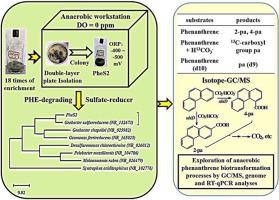Journal of Hazardous Materials ( IF 13.6 ) Pub Date : 2020-11-18 , DOI: 10.1016/j.jhazmat.2020.124522 Zuotao Zhang , Jiao Sun , Haijiao Guo , Xiaoqiang Gong , Chongyang Wang , Hui Wang

|
Polycyclic aromatic hydrocarbons (PAHs) are ubiquitous and harmful contaminants, which can be degraded aerobically. However, the persistence of PAHs in anoxic environments indicates that anaerobic biodegradation of PAHs should also be investigated. Pure-culture and biotransformation processes for anaerobic phenanthrene biodegradation with sulfate as a terminal electron acceptor remains in its infancy. In this study, we investigated anaerobic biodegradation of PAHs by PheS2, an isolated phenanthrene-utilizing sulfate-reducer, using phenanthrene as a model compound. PheS2 was phylogenetically closely related to Geobacter sulfurreducens and reduced sulfate to sulfide during anaerobic phenanthrene biodegradation. Phenanthrene biodegradation processes were detected using gas chromatography-mass spectrometry, genome, and reverse transcription quantitative PCR analyses. Carboxylation was the initial step of anaerobic phenanthrene biodegradation based upon detection of 2- and 4-phenanthroic acid, its isotopically labeled analogs when using 13C-labeled bicarbonate and fully deuterated-phenanthrene (C14D10), and genes encoding enzymes putatively involved in the biodegradation. Further, ring-system reducing and cleavage occurred, and substituted benzene series and cyclohexane derivatives were detected in downstream biotransformation metabolites. Additionally, PheS2 can degrade benzene, naphthalene, anthracene, and benz[a]anthracene, but not pyrene and benz[a]pyrene. This study describes the isolation of an anaerobic phenanthrene-degrading sulfate-reducer, the first pure-culture evidence of phenanthrene biotransformation processes with sulfate as an electron acceptor.
中文翻译:

硫酸盐依赖的Geobacter sulfreducens菌株PheS2厌氧降解菲的研究
多环芳烃(PAH)是普遍存在的有害污染物,可以通过需氧降解。然而,PAHs在缺氧环境中的持久性表明,PAHs的厌氧生物降解也应进行研究。以硫酸盐为末端电子受体的厌氧菲生物降解的纯培养和生物转化过程仍处于起步阶段。在这项研究中,我们研究了以菲为模型化合物的PheS2(一种利用菲的硫酸盐还原剂)的厌氧生物降解PAHs。PheS2在系统发育上与减少土壤杆菌有关并在厌氧菲生物降解过程中将硫酸盐还原为硫化物。使用气相色谱-质谱,基因组和逆转录定量PCR分析检测菲的生物降解过程。羧基化是厌氧菲生物降解的第一步,其基础是检测2-和4-菲甲酸,使用13 C标记的碳酸氢盐和完全氘代的菲(C14D10)时其同位素标记的类似物,以及编码可能参与生物降解的酶的基因。此外,发生环系统还原和裂解,并且在下游生物转化代谢物中检测到取代的苯系列和环己烷衍生物。此外,PheS2可以降解苯,萘,蒽和苯[ a]]蒽,但不包括pyr和苯[ a ] re。这项研究描述了厌氧降解菲的硫酸盐还原剂的分离,这是硫酸盐作为电子受体的菲生物转化过程的第一个纯培养证据。


























 京公网安备 11010802027423号
京公网安备 11010802027423号